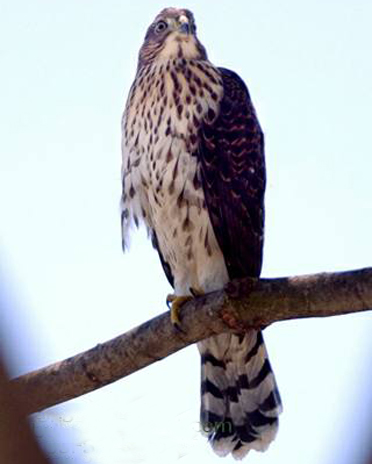Cooper's Hawk
The Cooper's Hawk (Accipiter cooperii) is a medium-sized hawk native to North America. It is a member of the Accipitridae family, which includes other raptors such as eagles, kites, and harriers. Here are some key characteristics and information about the Cooper's Hawk:Physical Description
Size:
Males are typically 14-18 inches long with a wingspan of about 24-35 inches. Females are larger, measuring 16-20 inches in length with a wingspan of 29-37 inches.Appearance:
Adults have a blue-gray back, reddish barring on the chest, and a long tail with dark bands. Juveniles are brown above with streaked underparts.Eyes:
Adults have red eyes, while juveniles have yellow eyes.Habitat
Range:
Cooper's Hawks are found throughout North America, from southern Canada to northern Mexico. They inhabit a variety of environments including forests, woodlands, and increasingly, suburban and urban areas.Nesting:
They build their nests in tall trees, often in wooded areas. The nests are constructed from sticks and lined with softer materials.Behavior
Hunting:
Known for their agility, Cooper's Hawks hunt by stealth, using their speed and surprise to catch prey. Their diet primarily consists of small to medium-sized birds, but they also hunt small mammals, reptiles, and insects.Flight:
These hawks are strong fliers and can maneuver through dense forests with ease. They have a characteristic flap-and-glide flight pattern.Reproduction
Breeding Season:
The breeding season typically starts in early spring. The female lays 3-5 eggs, which are incubated for about 30-36 days.Parental Care:
Both parents take part in feeding and caring for the young. The chicks fledge about 4-5 weeks after hatching.Conservation
Status:
Cooper's Hawks are currently not considered threatened. They have adapted well to urban environments, which has helped their population remain stable.Threats:
They face threats from habitat loss, collisions with windows, and human persecution in some areas.Interesting Facts
Name:
The species is named after the naturalist William Cooper.Adaptability:
Cooper's Hawks have shown remarkable adaptability to urban environments, often hunting in backyard feeders where small birds congregate.Summary
The page on Digital Desert titled 'Cooper's Hawk' provides information about this bird of prey, including its habitat, behavior, diet, and characteristics. Cooper's Hawks are known for their agility and speed, often hunting smaller birds in dense forests or urban areas. They have a distinctive appearance with a slate-gray back, reddish bars on their chest, and a long tail.
USFS photo
A breeding resident throughout most of the wooded portion of the state. Breeds in southern Sierra Nevada foothills, New York Mts., Owens Valley, and other local areas in southern California. Ranges from sea level to above 2700 m (0-9000 ft). Dense stands of live oak, riparian deciduous, or other forest habitats near water used most frequently.
Feeding: Catches small birds, especially young during nesting season, and small mammals; also takes reptiles and amphibians. Hunts in broken woodland and habitat edges; catches prey in air, on ground, and in vegetation. Often dashes suddenly from perch in dense cover and pursues prey in air through branches. Sometimes runs prey down in dense thickets. Uses cover to hide, attack, and approach prey; also soars and makes low, gliding search flights.
